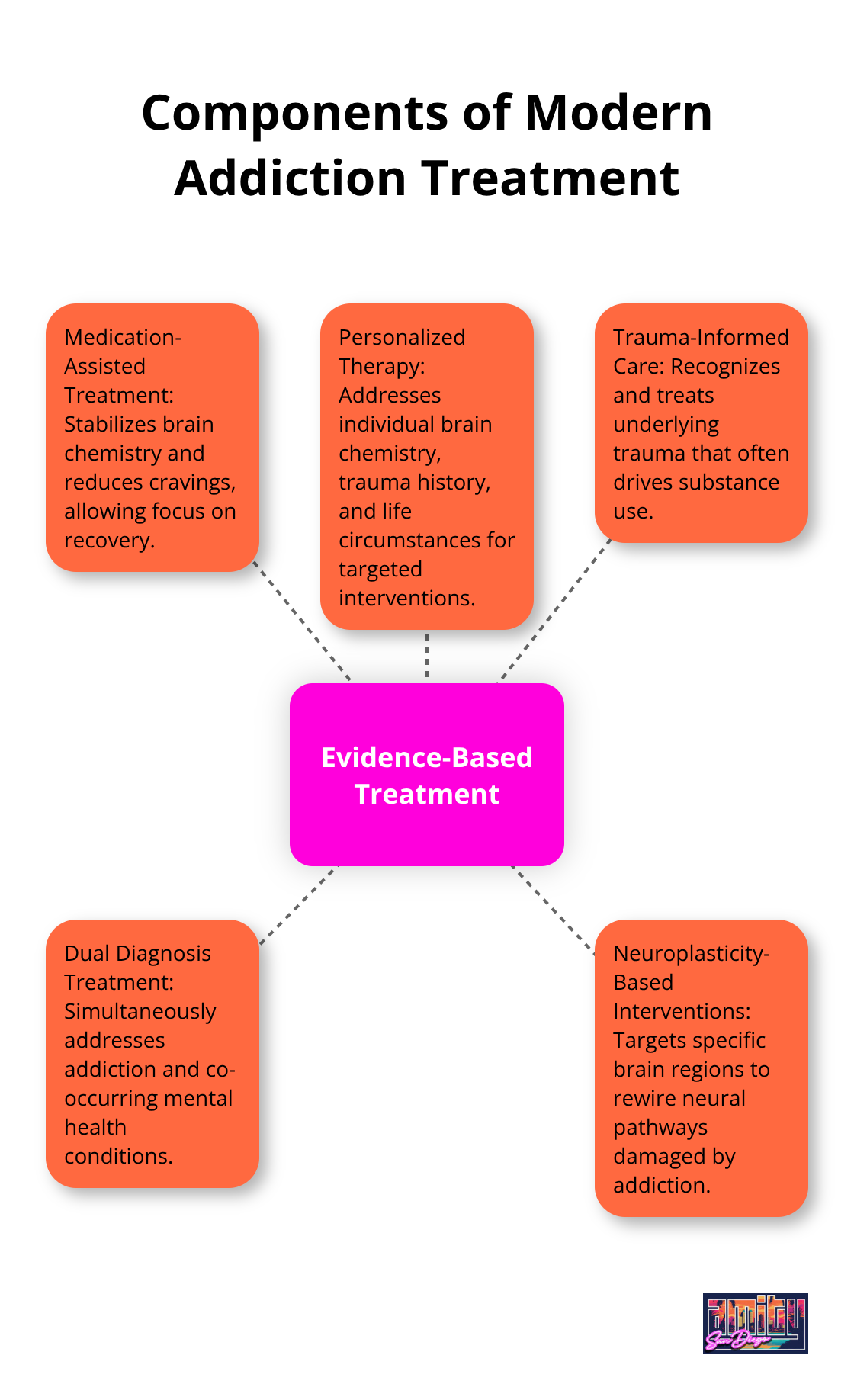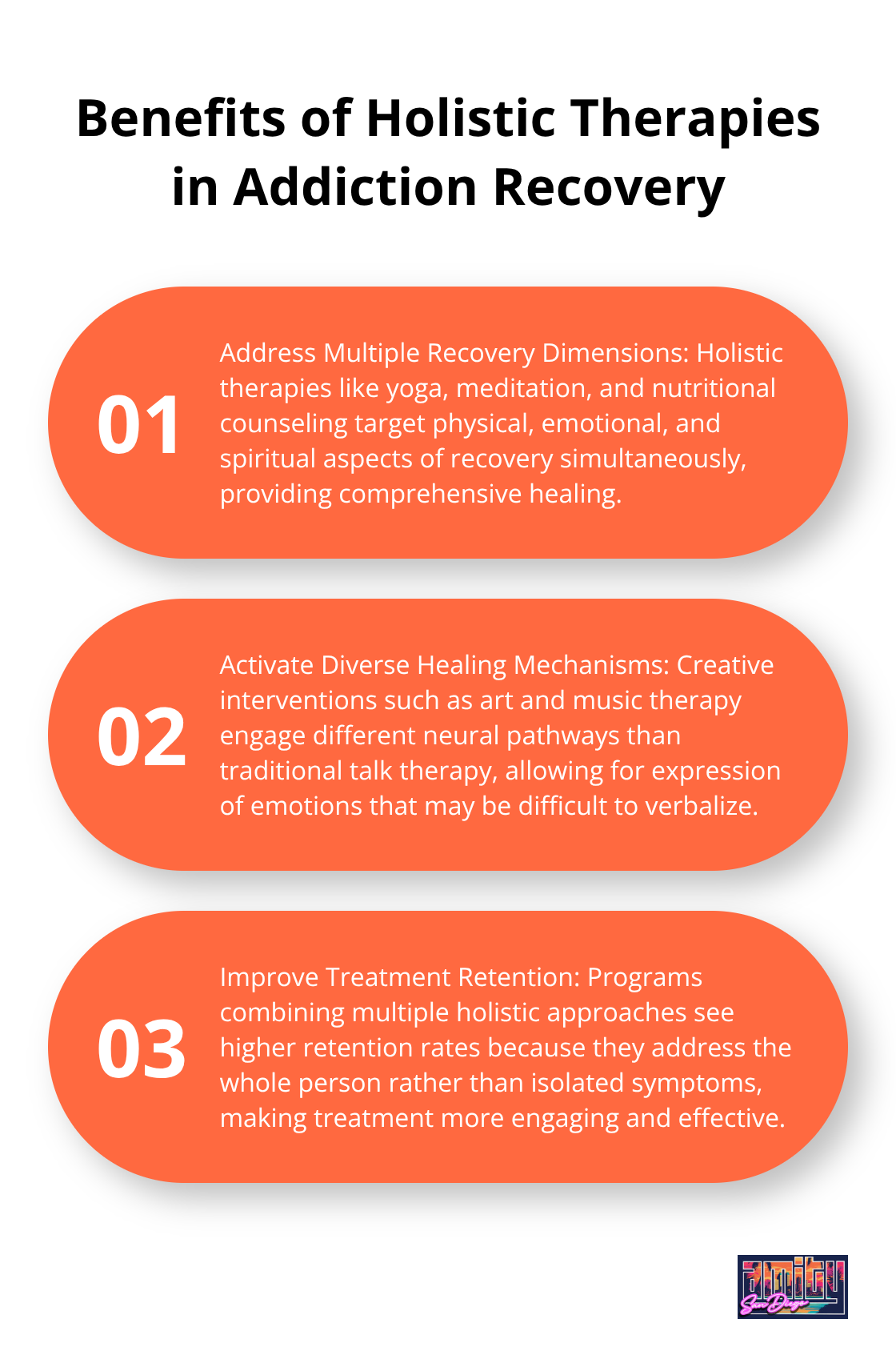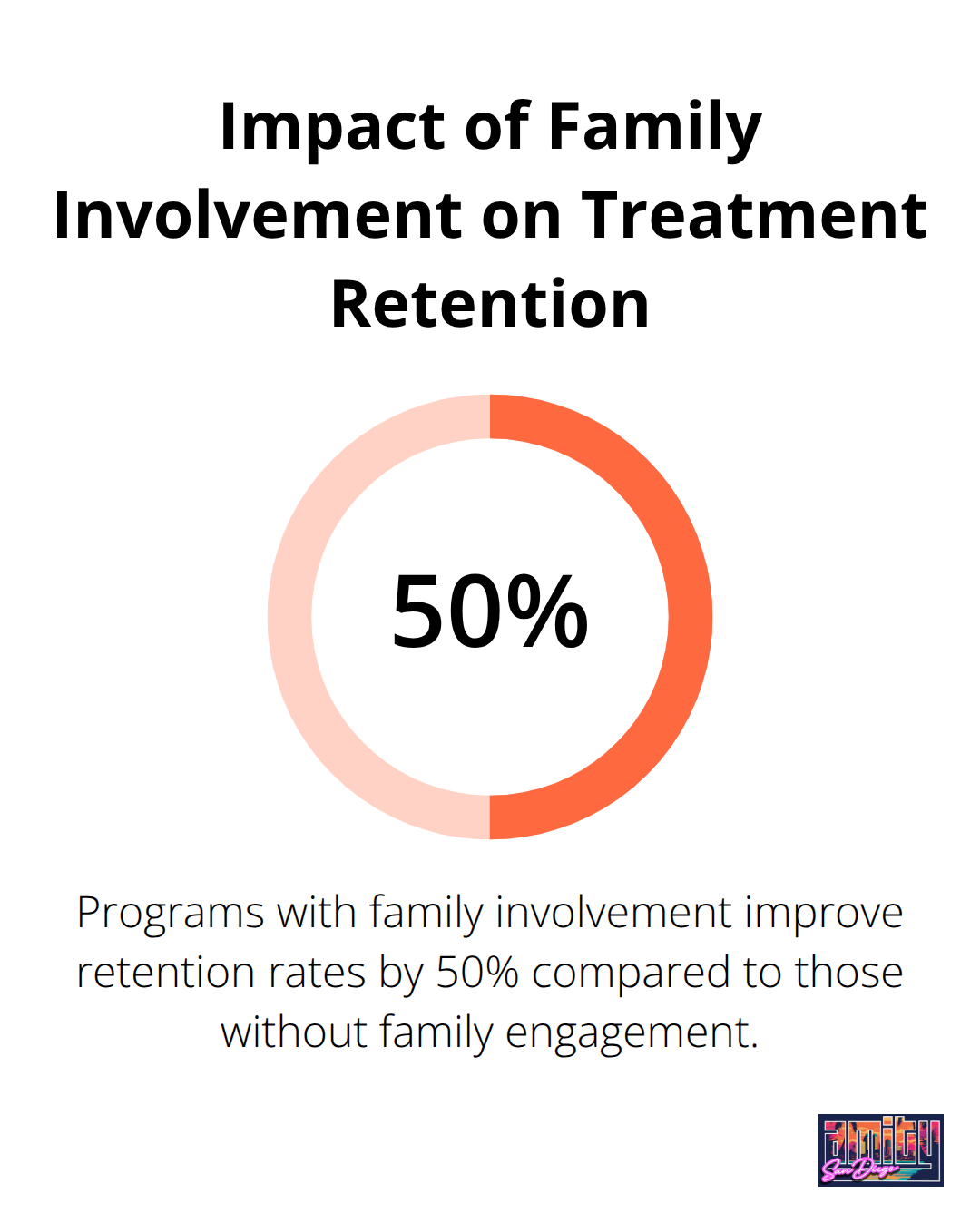Addiction recovery has evolved far beyond outdated methods that treat everyone the same way. Modern neuroscience shows us that effective treatment must address each person’s unique brain chemistry and life circumstances.
At Amity San Diego, we’ve seen how this rewired approach to addiction and recovery transforms lives. The old one-size-fits-all model simply doesn’t work for the complex realities of addiction today.
What Recovery Methods Actually Work Today
Traditional addiction treatment has failed millions of people because it ignores basic scientific facts about how the brain heals. The old 28-day rehab model assumes everyone responds the same way to identical interventions. Research from the National Institute on Drug Abuse proves this wrong, showing that combining medication with therapy reduces relapse rates compared to single-approach methods.
The Problem with Cookie-Cutter Treatment
Most traditional programs rely on group meetings and willpower alone. This approach fails because addiction rewires brain circuits differently in each person. The American Psychological Association found that Cognitive Behavioral Therapy produces small to moderate effects on substance use when compared to inactive treatment, but only when tailored to individual triggers and thought patterns. Generic CBT protocols miss the mark entirely.

The Substance Abuse and Mental Health Services Administration reports that peer support programs boost success rates significantly, yet most facilities still use outdated lecture-style group sessions instead of meaningful peer connections.
Evidence-Based Methods That Transform Lives
Modern treatment combines multiple proven approaches simultaneously. Medication-assisted treatment removes the shame while it addresses brain chemistry imbalances. Trauma-informed care addresses root causes rather than surface symptoms. The Journal of Substance Abuse Treatment published research that shows mindfulness practices decrease stress and cravings more effectively than traditional talk therapy alone. Treatment centers integrate these methods because single interventions simply don’t match the complexity of addiction. The brain needs comprehensive rewiring, not quick fixes.
Why Individual Treatment Plans Work
Personalized care addresses your specific brain chemistry, trauma history, and life circumstances. MIT research demonstrates that brain measures made at the end of treatment programs correlate with likelihood of future relapse when treatment considers individual risk factors (generic programs ignore these variables completely). Effective programs assess neurological patterns, co-occurring mental health conditions, and personal triggers to build targeted interventions. This approach works because it treats the person, not just the addiction diagnosis.
The Neuroscience Revolution in Treatment
Modern brain imaging reveals how addiction changes neural pathways differently in each person. This scientific breakthrough explains why traditional approaches fail so consistently. Neuroplasticity research shows the brain can rewire itself when treatment targets specific damaged circuits. Programs that ignore this science waste time and money while people continue to suffer. For those seeking comprehensive care, addiction treatment San Diego offers evidence-based approaches that address individual needs.
How Brain Science Changes Recovery Outcomes
Brain imaging studies from the National Institute on Drug Abuse show that addiction physically damages neural circuits responsible for decision-making, impulse control, and emotional regulation. This damage explains why willpower-based approaches fail consistently. Modern treatment must target these specific brain regions through neuroplasticity-based interventions.
The brain can rewire itself when treatment uses the right combination of medication, therapy, and behavioral modifications. Research indicates that people with addiction frequently have co-occurring mental health disorders like depression, anxiety, or PTSD. Traditional programs that treat addiction separately from mental health conditions achieve lower success rates because they ignore this biological reality.
Neuroplasticity Drives Real Brain Healing
Neural pathways damaged by substance use can rebuild themselves through targeted interventions. Research has documented how therapeutic activities can create new neural connections through consistent treatment. The brain forms alternative pathways around damaged areas when treatment provides the right stimulation.
This process requires more than talk therapy alone. Medication stabilizes brain chemistry while new neural networks develop. Behavioral interventions strengthen healthy pathways through repetition and reward. Programs that combine these approaches see higher success rates than single-method treatments.
Medication Removes Barriers to Brain Healing
Medication-assisted treatment works because it stabilizes brain chemistry while neural pathways rebuild themselves. Buprenorphine reduces opioid cravings significantly, which allows the brain to focus on recovery instead of survival. Naltrexone blocks alcohol reward pathways and gives people space to develop new coping mechanisms.
The stigma around medication prevents millions from accessing treatment that works. Modern programs integrate FDA-approved medications as standard care, not last resorts. These medications don’t replace recovery-they make recovery possible by removing chemical barriers to healing.
Dual Diagnosis Treatment Addresses Root Causes
Dual diagnosis treatment addresses addiction and mental health conditions at the same time because they share common brain circuits. Research shows that integrated treatment reduces hospitalization rates compared to sequential treatment approaches.
Programs must staff licensed psychiatrists and psychologists who understand both addiction medicine and mental health disorders. Generic counselors without dual training miss the complex interactions between these conditions, which leads to repeated relapses and treatment failures. Effective programs treat the whole person, not separate diagnoses.
This scientific understanding of brain healing sets the foundation for comprehensive treatment approaches that address every aspect of recovery. For those seeking evidence-based care, addiction treatment San Diego programs incorporate these neuroplasticity principles into their treatment protocols.
What Makes Recovery Programs Actually Work
Effective recovery programs treat addiction as a complex condition that affects every aspect of a person’s life. Research shows that programs with art therapy activate key neural networks that are also impacted by trauma, making creative interventions valuable treatment approaches for substance use disorders. Holistic approaches work because addiction disrupts physical health, emotional regulation, and spiritual connection simultaneously.
Programs that address only psychological symptoms ignore the body’s need for nutritional rehabilitation and physical healing. Research from the National Institute of Health demonstrates that regular exercise reduces cravings and improves mood more effectively than medication alone in many cases (this happens because physical activity releases natural endorphins that repair damaged reward pathways).
Holistic Therapies Address Multiple Recovery Dimensions
Yoga and meditation practices help people reconnect with their bodies after addiction disconnects them from physical sensations. Nutritional counseling repairs the metabolic damage that substances cause to organs and brain chemistry. Art therapy allows people to express emotions they cannot verbalize, which helps process trauma without re-traumatization.
Music therapy activates neural pathways that bypass damaged areas of the brain. These creative interventions work because they engage different healing mechanisms than traditional talk therapy alone. Programs that combine multiple holistic approaches see higher retention rates because they address the whole person rather than isolated symptoms.

Trauma Treatment Changes Everything
Most people with addiction have experienced significant trauma that rewires brain stress responses. Traditional programs that ignore trauma history achieve lower success rates because they don’t address the underlying triggers that drive substance use. Trauma-informed care helps individuals recognize the significant effects of trauma and develop healthy coping mechanisms instead of numbing emotional pain.
This approach works because it treats the cause, not just the symptoms of addiction. Programs must staff clinicians trained in EMDR, CBT, and other trauma-specific therapies to address these complex issues effectively (trauma specialists understand how past experiences create present-day addiction patterns).
Family Involvement Transforms Recovery Outcomes
The Family Therapy Journal reports that programs with family involvement improve retention rates by 50% because addiction affects entire family systems, not just individuals. Family members often enable addictive behaviors without realizing it, which sabotages recovery efforts when left unaddressed.
Family therapy sessions teach healthy communication patterns and boundary-setting skills. These interventions help families understand addiction as a medical condition rather than a moral failing. Programs that educate families about brain science reduce shame and increase support for long-term recovery success.

Aftercare Programs Prevent Relapse
Research shows that relapse prevention strategies including therapy and skill development, medications, and monitoring are among the most common approaches for maintaining recovery. Sustainable recovery requires continuous check-ins, peer support groups, and access to crisis intervention services. Most programs discharge people after 30-90 days without adequate follow-up support, which explains why relapse rates remain so high.
Effective aftercare includes sober living referrals, alumni engagement programs, and long-term therapy relationships that provide stability during vulnerable early recovery periods. These ongoing connections create accountability networks that help people navigate life challenges without returning to substance use. For comprehensive addiction treatment San Diego residents can access programs that integrate these evidence-based approaches.
Final Thoughts
Modern addiction recovery succeeds when treatment addresses each person’s unique brain chemistry, trauma history, and life circumstances. The evidence shows that personalized care combining medication-assisted treatment, trauma-informed therapy, and holistic approaches produces better outcomes than traditional one-size-fits-all programs. Generic 28-day rehab models fail because they ignore how addiction rewires neural pathways differently in each individual.
Programs that treat everyone identically waste time and resources while people continue to struggle. The brain needs comprehensive intervention that targets specific damaged circuits through neuroplasticity-based treatments. “Rewired: A Bold New Approach to Addiction and Recovery” represents this shift toward evidence-based, individualized care that recognizes addiction as a complex medical condition.
We at Amity San Diego combine medical interventions with personalized therapy approaches that treat co-occurring mental health conditions alongside addiction (these disorders share common brain circuits that require integrated treatment). Recovery requires ongoing support beyond initial treatment through aftercare plans, family involvement, and access to crisis intervention services. This comprehensive framework addresses the whole person rather than isolated symptoms, which creates sustainable pathways to long-term recovery success for those seeking addiction treatment San Diego.

